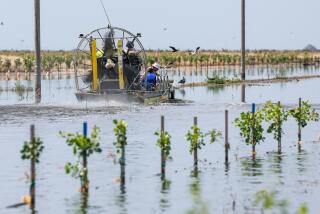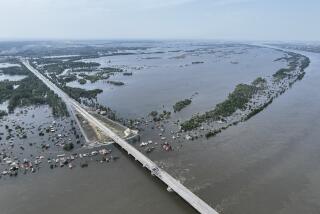A ‘Monster’ Strips ‘Pearl of Siberia’ of Its Luster : Pollution: A factory imperils the world’s oldest, deepest, most richly endowed lake. Economic disarray may ensure that the plant stays on.
- Share via
To produce “super” cellulose to make tough tires for Soviet air force jets, Moscow’s Cold Warriors turned to the sparkling pure waters of Lake Baikal in the middle of Siberia.
To keep pace with the American military of the 1950s, Soviet leaders were willing to pay the price: some chemical pollution of the crown jewel of Russia’s natural inheritance--known for generations as the Pearl of Siberia or the Sacred Sea.
In 1957, when Soviet citizens first heard about plans for the lake-shore factory at Baikalsk, their protest ignited an environmental movement that was a direct forebear of all Soviet activism to come, writer Don Belt reports.
But not until 1987 did the Soviet government issue a comprehensive decree protecting Lake Baikal, which Russians revere as Americans revere the Grand Canyon.
The decree abolished logging anywhere close to the lake. It declared that the Baikalsk factory, which was converted to a cellulose-paper plant after cellulose failed to make better aircraft tires, be “re-profiled.” By 1993 the plant is to be used for environmentally harmless activities.
Meanwhile, the dumping of industrial waste into Baikal continues. Bilious smoke still rises from the cellulose plant 24 hours a day.
And Belt heard Russians speak with uncensored passion about the factory: “our national disgrace,” “this monster.”
Because of the plant, some even spoke of the Baikal ecosystem as if it were already dead. But most scientists disagree with that dire conclusion.
There is no doubt that the plant makes Baikalsk one of the most polluted cities in Russia; cellulose-making is a dirty business. Yet the factory’s effluent is exceptionally clean by international standards.
Despite the 1987 government decree, closing the plant next year--in the midst of the greatest economic and political upheaval since the 1917 Russian Revolution--now seems a remote possibility.
Few seriously believe that the Russian government is going to shut down a top-producing cellulose plant, fire or retrain thousands of workers and come up with the millions of rubles it would take to turn the factory into something less objectionable. Baikalsk produces Russia’s second-highest volume of bleached cellulose, used to make clothing.
“In the foreseeable future,” Belt writes, “Baikal’s survival may depend, as it has for decades, on the great lake’s recuperative power--and the will of its defenders.”
Lake Baikal is older, deeper and more richly endowed with life than any lake on Earth. The 25-million-year-old body of water measures 5,371 feet deep and contains 1,500 endemic species, the greatest number in any lake anywhere.
Its elegant crescent shape holds one-fifth of the planet’s fresh water--more water than all of North America’s Great Lakes combined.
Baikal sits in the planet’s deepest land depression, a rift 5 1/2 miles deep, located in one of the most complicated fault zones on Earth.
The region around Baikal is rattled every few hours by an earthquake, usually a weak one. Warm-water springs on the lake bottom indicate that powerful tectonic forces are still at work in the rift.
“Imagine what science could learn from a 100,000-year-old man,” says Mikhail Grachev, director of the Limnological Institute in Irkutsk. “That’s what Baikal is like to a biologist--a natural laboratory for the study of evolution.”
A 1990 Soviet-American expedition made a striking discovery: Freshwater sponges and other animals thriving around the warm-water vents.
Baikal is incredibly rich in life at all depths. As its cold waters sink, they carry oxygen even to the deepest parts.
Baikal is indeed a living museum of aquatic plants and animals, including 52 species of fish and more than 250 species of freshwater shrimp.
One shrimp species renders the water strikingly pure by straining out algae and bacteria. The purity of water from the lake’s center is so great that it becomes tainted by laboratory glass.
On the outskirts of Baikalsk, Belt met a ragtag, rain-soaked band of protesters, most of them disabled. They had walked--or rolled in wheelchairs--about 200 miles to denounce the cellulose plant.
“Then I understood,” Belt writes, “how people who have had nearly everything taken away will fight to keep the one beautiful thing they have left.”
Sergei Vasiliev, regarded as the greatest of the Baikal ship captains, piloted the research vessel Albatross when it first brought the Soviet intelligence-gathering commission to the proposed site of the cellulose plant in 1954.
Still haunted by that fateful voyage, Vasiliev told Belt: “Helping to bring this monster to Lake Baikal--this is the one great regret of my life.”
More to Read
Sign up for Essential California
The most important California stories and recommendations in your inbox every morning.
You may occasionally receive promotional content from the Los Angeles Times.










